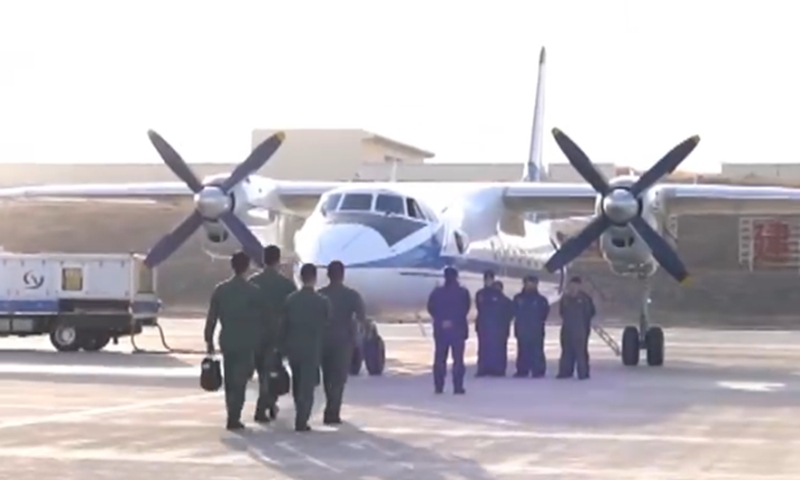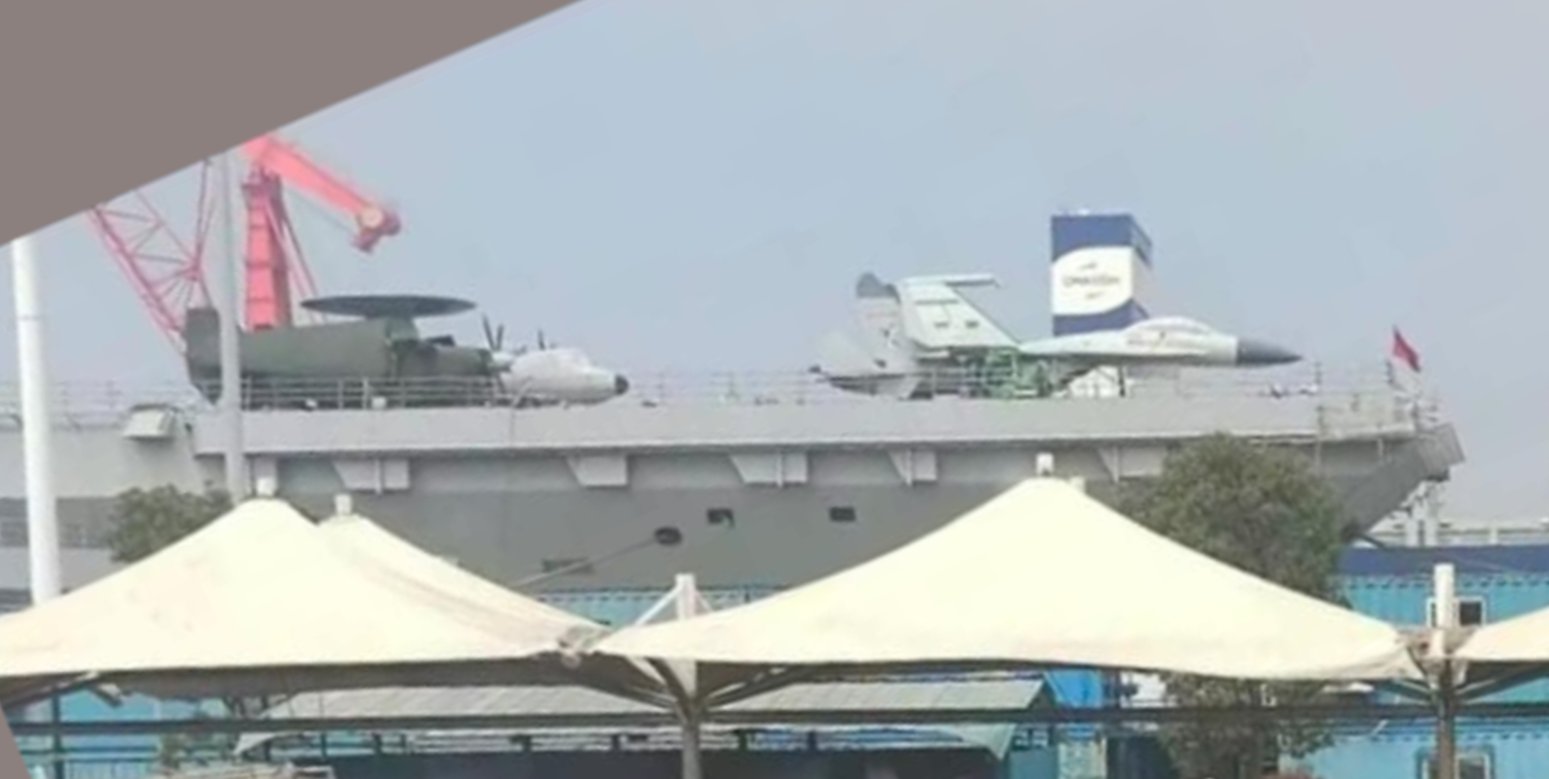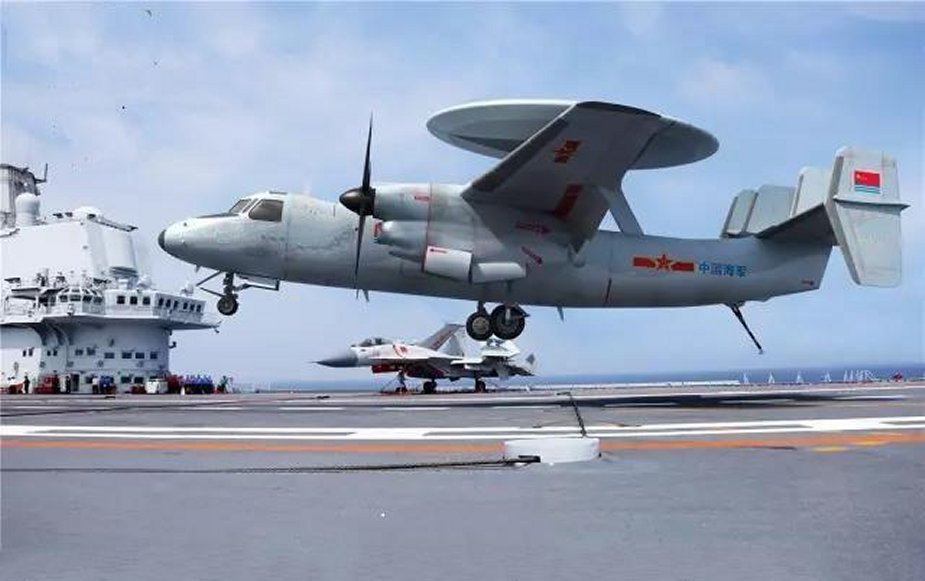China might have started training its military pilots to fly the futuristic ‘eye in the sky,’ the KJ-600 airborne early warning and control (AEW&C) from the country’s latest aircraft carrier, Fujian.
State-owned CCTV revealed on February 5 that China’s military has accelerated pilot training for the carrier-based “special mission aircraft” ahead of the deployment of Fujian, the nation’s first aircraft carrier with an electromagnetic catapult.
The report stated that the People’s Liberation Army’s Naval Aviation University is training pilots on the Y-7 transport aircraft to simulate carrier-based training procedures as preparation for the induction of a carrier-based “special mission” aircraft.
Although the report did not directly name the special-mission aircraft in question, the pilots are believed to be training to fly the KJ-600. The assumption is based on the fact that pilots are being trained on the Y-7 transport aircraft—which has served as a testbed for the KJ-600.
China’s accelerating pilot training for carrier-based aircraft appears to be aimed at plugging a key skill gap. Previous reports alleged that Beijing was hiring former fighter pilots from the West to train its aviators as it lacked qualified resources.
An article published in Ordnance Industry Science Technology, a Chinese military magazine, highlighted how the Chinese Navy still doesn’t have a fighter trainer designed for carrier-based operations despite deploying its first aircraft carrier a decade ago.

More importantly, though, the training has been expedited ahead of the induction of the Fujian aircraft carrier, scheduled for sometime later this year.
China’s indigenously developed Fujian aircraft carrier is only the second in the world to feature electromagnetic catapults, which will enable the PLAN to launch heavier and larger fixed-wing aircraft with more fuel and weapons loads.
The Fujian will likely host the fifth-generation J-35 stealth aircraft and the J-15T, an upgraded variant of China’s first carrier-capable fighter jet. Last year, a broadcast featuring a Fujian insignia also showed what appeared to be an early warning aircraft flying over the carrier with a J-35 fighter jet.
Additionally, a set of images that surfaced on the social media platform Weibo showed scaled models of KJ-600 early warning and control aircraft displayed on the flight deck of Fujian along with a stealth jet.
Chinese state media posits that China’s strategic position in the seas will be buttressed with the anticipated integration of the KJ-600 into People’s Liberation Army Navy (PLAN) operations, allowing it to improve its aerial command and maritime surveillance capabilities.

These early warning aircraft can collect vast data, analyze it, and transmit information to other combat units. These special mission aircraft can also detect, track, monitor, and direct attacks against hostile targets.
Moreover, aircraft carriers need early warning systems in modern combat when operating far from land. Ground-based early warning aircraft can only assist carrier-based fighters operating near land, not when cruising in distant waters. Thus, a KJ-600 sitting on the deck of the Fujian aircraft carrier will be akin to having ‘eyes in the skies.’
KJ-600 Aboard Fujian Will Expand China’s Capability
The KJ-600, like most Chinese military platforms, remains cloaked in secrecy, except for rare sightings posted on social media. But from what we know, the KJ-600 aims to achieve multi-domain, multi-platform joint connectivity, data transmission, and targeting.
In March 2024, the KJ-600 was photographed at an unidentified location during flight testing. The images at the time showed the aircraft with a straight high-wing shape, a four-fin tail, and tricycle landing gear—features that underscore China’s ambitions to enhance its maritime surveillance and aerial command capabilities.
Based on measurements from satellite photography, the KJ-600 is believed to have a wingspan of 24.4 meters and a length of 18.4 meters. This is consistent with the small size of an aircraft to be deployed on a carrier.
Based on satellite imagery, experts predicted that the six-bladed turboprop engines are most likely that of the WJ-6C. It was assessed that the catapult launch bar on the nose landing gear confirms CATOBAR launch compatibility, while a small tailhook tip and a rear Y-shaped depression in the fuselage effectively demonstrate the existence of a Y-shaped tailhook for arrested recovery.

Notably, the Type 001 Liaoning and Type 002 Shandong carriers that China currently operates are not expected to be the KJ-600’s primary carriers as they are outfitted with ski-jump ramps. This essentially points to the KJ-600’s deployment aboard the Fujian. The turboprop-powered KJ-600 will most likely require a catapult, of which Type 003 ‘Fujian’ has three.
The aircraft’s main objective would be to enhance the carrier’s radar range, particularly in identifying objects flying at low altitudes. However, it would also be equally responsible for battle space management. Onboard controllers would serve as battle space awareness, central command and control, and aircraft vectoring, as required for highly coordinated operations.
Earlier, a report published in the Global Times stated that China had demonstrated the ability of an unidentified early warning aircraft to network with the J-15 carrier-launched fighter jet.
“During the drills, the early warning aircraft formed a communications network and established an information chain, detected and located target radiation sources, and commanded and guided the fighter jets to conduct attacks against targets at sea,” the Global Times report said.
In the same report, Chinese experts said: “With the KJ-600 expected to board China’s third aircraft carrier, the electromagnetic catapult-equipped Fujian, coordination between carrier-based fighter jets and early warning aircraft will accelerate the improvement of combat capabilities.”
The KJ-600 is viewed as a “copycat” of the Northop Grumman E-2 AEW&CS aircraft, as previously explained by the EurAsian Times. US experts feel the PLA has been maturing surveillance planes like the KJ-600 and replicating the successful features of the E-2D Hawkeye.
However, given the ongoing tensions in the Indo-Pacific, a carrier-based AEW&C aircraft is essential for China to carry out operations against the enemy.
Chinese experts have repeatedly highlighted that coordination between carrier-based fighter jets and early warning aircraft will speed up the upgrading of combat capabilities, and that is what China is preparing for.
- Contact the author at sakshi.tiwari9555 (at) gmail.com
- Follow EurAsian Times on Google News




